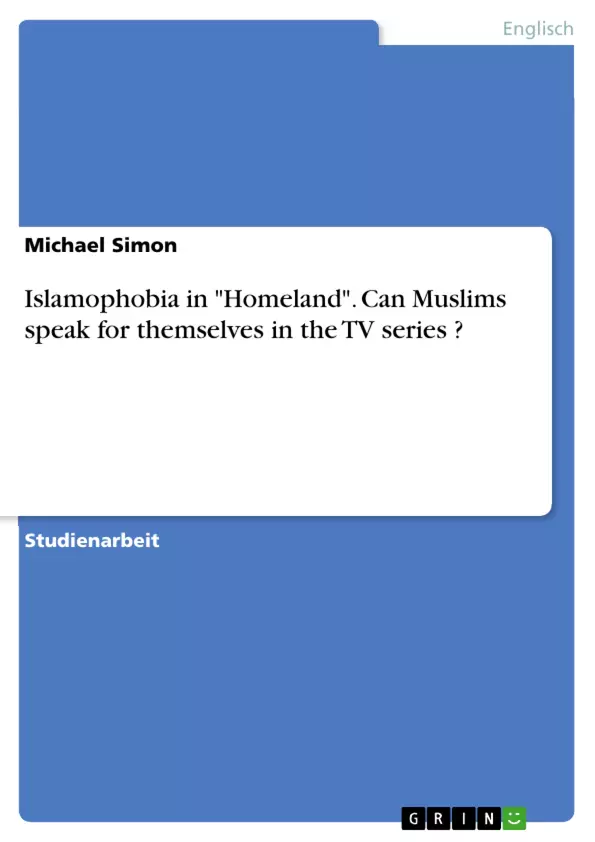In fall of 2011, many critics celebrated Homeland as the best show of the season. One year later, similar reviews could be read. But since the pilot of the first season of the show, voices of strong disapproval mixed with the applause. These voices did not just criticize some logic errors in the story writing or sloppy acting (justifiably or not) but brought up a serious accusation: Homeland displaying islamophobic representations. As an example, Laila Al-Arian states that the show has the “insidious implication that Muslims, no matter how successful, well-placed and integrated, are a hidden danger to their fellow Americans”. I would like to analyze and explore the hints and underlying premises of the show on whether or not islamophobic tendencies and representations can be discovered and, if so, to which extend.
Why is it important to ask these questions? In an article, The Guardian foreign affairs editor Peter Beaumont describes the way “‘the other’ – those whom we fear or are suspicious of –“ is depicted in popular films and TV shows can reinforce “cultures of conflict” because “[p]opular culture both informs and echoes our prejudices”. The show claims to be close to reality and tries to showcase this for example by putting 9/11 witness footage and real politicians such as President Clinton, President Obama (who himself is a fan of the show) or Commander Colin Powell into the opening credits, which is an attempt to convey credibility and authenticity to the viewer.
But that exactly is why it is important to consider how religious groups, minorities or ethnicities are represented. Popular culture is capable of reinforcing images and prejudices, and a show like Homeland that tries to appear credible to his viewer needs to be sensitive about this. Additionally, islamophobia is indeed a pressing issue. Ramon Grosfoguel argues in the Islamophobia Studies Journal that since 9/11 “anti-Arab racism through an Islamophobic hysteria[escalated all over the world”. One finding in a study about representations of Muslims in the Wall Street Journal was that the terms ‘Muslims’, ‘fanatics’ and ‘terrorists’ are absurdly used as “interchangeable co-words” (Joseph and D’Harlingue). These are just two examples that show a glimpse of the complexity and pertinence of islamophobia.
Inhaltsverzeichnis
- Introduction
- Depiction of Muslim protagonists in Homeland
- Analyzing Nicolas Brody
- Depiction of Americans in Homeland
- Problematic representations in Homeland
- Résumé
Zielsetzung und Themenschwerpunkte
Die vorliegende Arbeit untersucht islamophobe Tendenzen und Darstellungen in der Fernsehserie Homeland. Sie analysiert, ob und in welchem Maße die Serie islamophobe Tendenzen aufweist und beleuchtet die Frage, ob muslimische Figuren in der Serie ihre eigene Stimme haben.
- Analyse der Darstellung muslimischer Figuren in Homeland
- Untersuchung des Einflusses von Orientierungsdiskursen auf die Darstellung von Muslimen
- Beurteilung der Glaubwürdigkeit der Serie im Hinblick auf die Darstellung von Realität und Fiktion
- Analyse der Beziehung zwischen amerikanischen Figuren und muslimischen Figuren in Homeland
- Identifizierung problematischer Darstellungen von Islam und Kultur
Zusammenfassung der Kapitel
- Introduction: Die Einleitung präsentiert den Kontext der Analyse und stellt die Relevanz der Thematik Islamophobie in der Populärkultur heraus. Sie beleuchtet den Einfluss von Orientierungsdiskursen auf die Darstellung von Muslimen und die Bedeutung von glaubwürdigen Darstellungen in der Fernsehserie Homeland.
- Depiction of Muslim protagonists in Homeland: Dieses Kapitel analysiert die Darstellung muslimischer Figuren in den ersten beiden Staffeln von Homeland. Es untersucht, ob diese Figuren ihre eigene Stimme haben und wie sie in Bezug auf ihre Kultur, Religion und ihre Rolle in der Geschichte dargestellt werden.
- Analyzing Nicolas Brody: Dieses Kapitel analysiert die Figur von Nicolas Brody im Detail. Es untersucht, wie seine Geschichte erzählt wird, wie er von anderen Figuren wahrgenommen wird und ob er in der Serie die Möglichkeit hat, seine eigenen Erfahrungen und Perspektiven zu kommunizieren.
- Depiction of Americans in Homeland: Dieses Kapitel analysiert die Darstellung amerikanischer Figuren in Homeland und untersucht, wie sie mit den muslimischen Figuren interagieren und wie sie in Bezug auf ihre Kultur und ihre Rolle in der Geschichte dargestellt werden.
Schlüsselwörter
Die Schlüsselwörter dieser Arbeit sind Islamophobie, Orientierungsdiskurs, Darstellung von Muslimen, Fernsehserie Homeland, Glaubwürdigkeit, Kultur, Religion, Interaktion, Identität.
- Quote paper
- Michael Simon (Author), 2017, Islamophobia in "Homeland". Can Muslims speak for themselves in the TV series ?, Munich, GRIN Verlag, https://www.grin.com/document/369188



